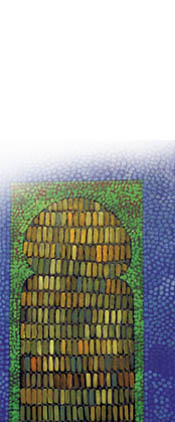
|
 |
This article appeared in Evening News, Karachi, Pakistan in July, 2000
Lubna Agha: personal saga of an inward journey
By Hameed Zaman
Lubna Agha, who once took the city by storm when she returned from her London sojourn, graduating from mere learner to an accomplished artist, is now visiting Karachi in a different mood with a mystic aura, displaying her work which she did during her stay at Sacramento and Boston, USA. It turns out to be an interesting journey of creativity, beginning from 'White on White' period where 'less was more' in a minimalist way which despite critical and financial success, she herself described as a 'trap'.
"I had stopped taking risks. I had imprisoned myself in my own comfort; I was afraid of change," She says. But all said and done, her 'White on White' period did expose a mystic streak which since then is getting more and more pronounced in her work till she was finally ready for an "encounter with my inner self".
Her 1993 exhibition at Chawkandi Art, was a stop-gap arrangement for an exercise in sublimation, rest and rethinking, making her paintings to become more contemplating and as she put it, "letting doubts by my guide".
In fact, her latest paintings on display are the expression of Lubna's personal saga of an inward journey, a difficult process of passing through a purgatory that she accomplished by holding the finger of a great mystic poet Maulana Rumi. As her paintings indicate, she was passing from the realm of al-Zahir to al_Batin. These spiritual dimensions of her work are both dramatic and courageous where good and evil are in conflict, both within and without.
Lubna is obviously concerned with 'Haqiqat' (truth), therefore, her paintings are both disturbing and inspiring. She is displaying a propensity for contemplation and meditation, exploring the path of inwardness. Her visualization and interpretation of the mystic thoughts of Rumi retain the mystery of introspection.
Her major paintings are basically concerned with the enigma of life and death where death is as much a source of nourishment as life, each interacting to complete the cycle of existence. An eerie silence prevails all over the 'eternal rest'. There is no melodramatic turmoil of existentialist struggle. It is a world of submission.
In an extraordinary visualization of a spiritual experience: 'Chilla', a dervish is shown absorbed in meditation. He is sitting wrapped within a protective orb, a kind of magic circle which cannot be broken by the evil force assailing the dervish in the forms of ravens, a symbol, perhaps, taken from the annals of witchcraft. The eyes of the dervish are closed though the eyes of his heart are open. The deep blue area which surrounds the dervish symbolizes the 'Sea of Being' where he is attempting to drown his self, for 'not Being is the mirror of Being', as Rumi said long, long ago.
In her painting: 'Limited Access', hands are used as a metaphor, not of resistance but of banging the doors in protest, pushing them for an entry from where they have been barred. Through hands, the artist is attempting to extend the limits, seeking access to the forbidden realms.
She has almost attempted to illustrate Rumi's famous verse: "Like fish we say to ocean of life, why did you send up waves and throw us into the dryness of water and clay? You possessest such mercy, why dids't thou give us such torment?"
In a way, art in life in a mystic system, are at an uncomfortable odd, yet any attempt for self-transcendence cannot cancel out the simple fact that self must endure and that the life lived before transcendence is possible. For a man cannot escape the vicissitudes of life and going through the path of torment is an inescapable truth. The painting is almost a literal illustration with fish and ocean and tormented beings trapped in purgatory. Technically speaking the tones and textures provide a washed-out blur producing a hazy glimpse of the world hereafter. The tilting figures are suspended in a void, red color dominating.
Lubna is addicted to dividing the space in panels, each filling their own space with repeated patterns of motifs or symbols, each panel providing a counter-point. Her forms are disciplined, composed and ironed into visually powerful imagery. The stylized range of symbolic motifs---fish, roots, trees, coffins, etc, borrowed from the land, sea and air support her circle of life-death cycle. The symbols are repeated but every time they are extended and improved in order to explore further, highlighting the intensity of the reality behind her theme.
These signs and symbols are indicative of Lubna's personal investigation: some are realistic, others loose and free, some bordering on abstraction, yet there is a unique control and unity within the artistic work retained. She is an artist of profound ability, important feature of her art being her conviction and faith in the mystic spirituality of the meaningful existence.
The rendition of Ismat Chughtai's short story 'Ghunghat' is yet another painting of Lubna, which is as thought provoking as the story itself. Here man-woman relationships have been described in a sociological perspective, where women are shown terror stricken, hence alienated, living in their shells, lonely in a man-dominated world. There seems to be no emotional fusion between the two genders, each attempting to preserve her or his identity instead of sharing the existence of total unity.
Her another painting 'Eternal Rest' is the added sum of extended life continuity where even after death a human lives in a state of torment.
So with tears and torments Lubna Agha continues her inward journey of self-discovery.
|
 |
 |


